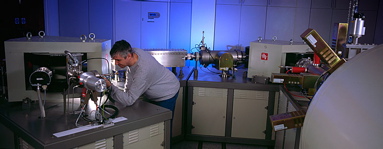WP-7 Data synthesis and age modelling
 Age models provide the chronological framework essential for the proper understanding of the human response to changes in environment. In the past such age models have been ‘best estimates’, based on a combination of scientific dating and correlations with other dated records. For the study of abrupt environmental transitions (AET) this approach will not suffice since the assumption of synchronicity is often built into the analysis and the uncertainties in the scientific dating (often not quantified) are too large to allow high-resolution comparison. New developments in statistical modeling techniques in combination with the multiplicity of chronostratigraphic tie points provided by tephra layers (see WP-5 and WP-6) should, for the first time, allow high resolution age models to be constructed which combine good relative chronological precision with a proper assessment of absolute and relative timings.
Age models provide the chronological framework essential for the proper understanding of the human response to changes in environment. In the past such age models have been ‘best estimates’, based on a combination of scientific dating and correlations with other dated records. For the study of abrupt environmental transitions (AET) this approach will not suffice since the assumption of synchronicity is often built into the analysis and the uncertainties in the scientific dating (often not quantified) are too large to allow high-resolution comparison. New developments in statistical modeling techniques in combination with the multiplicity of chronostratigraphic tie points provided by tephra layers (see WP-5 and WP-6) should, for the first time, allow high resolution age models to be constructed which combine good relative chronological precision with a proper assessment of absolute and relative timings.
Aims and Research Objectives
The aim of this work package is to provide comprehensive age models for all records and sites involved in this study and thereby to assess the phase relationships, relative timings and environmental characteristics of AETs. This will be addressed through a series of research objectives:
- To combine all of the relative and absolute chronological information into a single comprehensive age model
- To provide age depth models with uncertainties for all the continuous records in the study
- To provide age estimates with uncertainties for all the individual archaeological samples studied as part of the project
- To provide updated estimates, with uncertainties, of all the relevant tephra layers
- To assess the nature of the AETs by analysis of the relative timings of different aspects over a wide geographical range
- To provide additional information on the earth-system mechanisms operating during AETs
The key hypothese in this WP is that, by integrating absolute dating information together with synchronous chronological markers (provided principally by tephra), it is possible to establish the relative timings and phase relationships of AETs to address the hypotheses of WP-1 to WP-6. The methodology developed will have relevance to future research of this kind.
 Research focus
Research focus
We will build comprehensive age models incorporating all of the chronological information relevant to the project. The model will be based on a Bayesian statistical framework. Age likelihoods will be
provided by absolute date information (from marine and terrestrial radiocarbon dates, ice cores, and other direct dating methods such as Ar-Ar, OSL and uranium series) and the prior model will incorporate all of the relative age information and synchronous markers (from tephra layers, 10Be spikes and varves) and other information which gives us extra temporal information (such as depth in cores).
Separate models will be generated for each of the time periods under consideration. The age models will have a resolution of decadal to centennial level for WP3 and centennial to sub-millenial level for
WP1 and 2. Relative age information close to the AETs should be better than the absolute age information and approach the decadal level near marker horizons. Because of the nature of the Bayesian framework all such information will have quantified uncertainties. We will test internal consistency between marine and terrestrial radiocarbon measurements for specied AETs to see if there is evidence of significant changes on global carbon circulation or radiocarbon production rates.

Radiocarbon AMS at Oxford (c) James King Holmes
 Research focus
Research focus Age models provide the chronological framework essential for the proper understanding of the human response to changes in environment. In the past such age models have been ‘best estimates’, based on a combination of scientific dating and correlations with other dated records. For the study of abrupt environmental transitions (AET) this approach will not suffice since the assumption of synchronicity is often built into the analysis and the uncertainties in the scientific dating (often not quantified) are too large to allow high-resolution comparison. New developments in statistical modeling techniques in combination with the multiplicity of chronostratigraphic tie points provided by tephra layers (see WP-5 and WP-6) should, for the first time, allow high resolution age models to be constructed which combine good relative chronological precision with a proper assessment of absolute and relative timings.
Age models provide the chronological framework essential for the proper understanding of the human response to changes in environment. In the past such age models have been ‘best estimates’, based on a combination of scientific dating and correlations with other dated records. For the study of abrupt environmental transitions (AET) this approach will not suffice since the assumption of synchronicity is often built into the analysis and the uncertainties in the scientific dating (often not quantified) are too large to allow high-resolution comparison. New developments in statistical modeling techniques in combination with the multiplicity of chronostratigraphic tie points provided by tephra layers (see WP-5 and WP-6) should, for the first time, allow high resolution age models to be constructed which combine good relative chronological precision with a proper assessment of absolute and relative timings. Research focus
Research focus